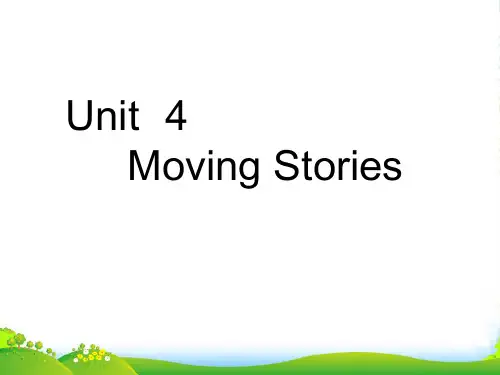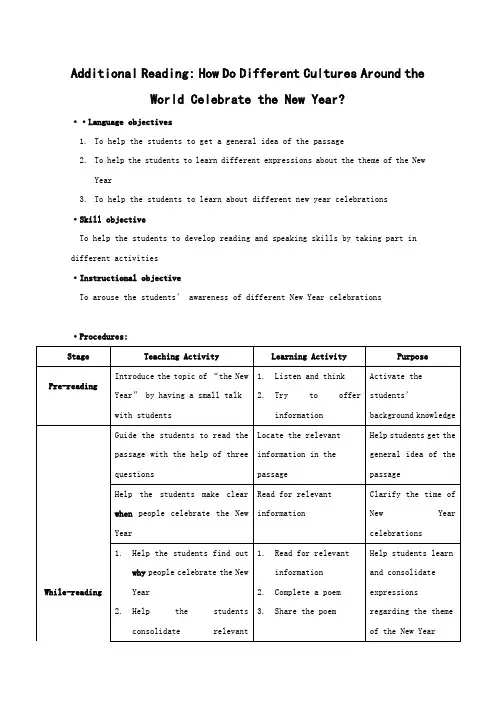上海新世纪英语高一课文讲解(初三衔接高中):4---5
- 格式:doc
- 大小:75.50 KB
- 文档页数:5

11. Cartoons and comic strips. @People often find it hard to put their feelings into word s. So they keep hunting for new means of expressing their feelings o ther than words. Cartoons, as such a means, were thus born. Old cartoons, however, did not attract many people until cartoonists had expanded their topics by the end of the 19th century.At around the same tim e, comic strips came into being.A cartoon is an amusing drawing that deals with something of interest in the news. Comic strips are a set of humorous drawings that tell a funny story. . @They make a story appear as a picture in the reader’s mind by showing one or two aspects of an event.There is a cartoon that shows a father and his son. The boy is showing his father his school report, which, unfortunately, gives a very poor grad e---2 out of 5. So he does it in a quite unusual way: . @the report is fastened to one end of a pole while the boy is holding the other and. With the long pole between them, any punishment from the father is out of the question.For the moment, at least, the son is safe.Readers can’t help laughing at the cartoon. But they may also find some f ood for thought in addition to being amused.Reading cartoons and comic strips had long been a favourite pastime for adults until the beginning of the 20th century. Then some business-minded people found that there might be a good market for children, too. . @With the improvement of printing and drawing techniques,modern cartoons and comic strips had become children’s favourites by the early 20th (around the 1920s). Since then they have become popular reading materials for people of all ages.. @Today the characters in cartoons and comic strips range from children to adults, pets to fancy animals, and ordinary people to superheroes. Micky Mouse and Garfield the Cat make children think and imagine actively. Superman and Batman bring villains of all sorts to justice. Father and Son expresses human love and sympathy in lively comic strips. Their names have become household words. They are only a few outstanding products in the field.Today the digital revolution has brought new life to the making of cartoons and comic strips. Therefore many people think that computer-made comics will in the end replace hand-drawn ones. . @However, just as the human mind will never give way completely to the computer, hand-drawn comics will never die, but will remain a special means of expressing human feelings.Word study:1. People often find it hard to put ...句型结构:find (think / believe / feel) it hard (/easy / difficult) (for sb.) to do ...You try:1). 我们发现很难学好使用电脑。

6. Never too busy for social mannersSo you forgot to answer that party invitation you received. Now, the day has come and gone, and you’re feeling guilty because you never told the host you couldn’t attend.“Don’t allow this oversight(疏忽) to ruin your relationship,” says R. Thomas Boone, a US social psychologist. “I would show up with a bottle of wine and say, ‘I owe(感激,亏欠) you one. I’m really sorry’,” Boone says.. @Send an e-mail, make a phone call or reach out to the host another way. Whatever the method, do it as soon as possible.If guests don’t answer the invitations on time, the host cannot possibly plan for the correct amount of food and drink. . @This may lead to hundreds or even thousands of dollars of waste.“Everybody has a busy schedule now,” B oone says. If you know you are forgetful when it comes to making phone calls, try emailing your RSVPs as soon as the invitation arrives. RSVP is the short form of the French phrase “répondez s’il vous plaît”, meaning “Reply, if you please”.The following are some commonly used terms in invitation letters and their meanings. . @Be sure to know these and answer invitations properly.RSVP, REGRETS ONLY Only guests who can’t attend need reply. You need to give a proper reason why you can’t attend.RSVP BY… Gue sts should respond with yes or no by the date indicated on the invitation. Setting a date gives guests a deadline. It is also a deadline for the host to connect guests who haven’t reply.RSVP BY E-MAIL . @Guests can respond by e-mail. Unlike phone calls, e-mails can be sent without regard to time of day or location.7. Holidays and festivals in the United Kingdom. @There are many national holidays in the United Kingdom. Among them, Easter, and Christmas are two of the most famous.EASTER The date of Easter varies each year. It usually falls in March or April. During the Easter holiday, people give each other chocolate Easter eggs. The eggs are opened and eaten on Easter Sunday. On Good Friday (the day before Easter, when Christians observe the day on which Christ died), hot cross buns(复活节前一个星期五吃的十字面包) are sold. They are toasted and eaten with butter. Easter Monday (the day after Easter) is a Bank Holiday. On that day, banks and other major businesses are closed; people may enjoy a trip to the seaside or watch an exciting sports game, such as football, or horse-racing.CHRISTMAS For most British families, Christmas is certainly the most important holiday of the year. Families decorate their houses in bright colours. Usually a Christmas tree is placed in the front room,shining with coloured lights and interesting decorations.On the morning of Christmas Day (December 25), many people go to church to celebrate the birth of Christ(耶稣基督). . @In the afternoon, they stay at home and open the gifts that were gathered around the tree. Later, they may watch the Queen appear on television to deliver her traditional Christmas message to the whole country.. @In the evening, the families sit down to a big goose (sometimes turkey) dinner. They round off the meal with pudding, a Christmas specialty.Many traditions are connected with Christmas. For children, the most important one is that of receiving gifts. On Christmas Eve (December 24), they usually leave a long stocking hanging by the bed or by the fireplace. They hope that Father Christmas willcome down the chimney during the night and bring them small presents. They are usually not disappointed!December 26, Boxing Day, is also a public holiday. . @This is the time to v isit friends or watch football. Students have several weeks off school for Christmas.Word study:P1 1. throughout +时间/ 事情/ 区域eg. throughout the day/ his illness/ the worldP2 2. vary vi. 改变(pt.pp. varied) vary in sth. 在…方面不同eg. People vary in intelligence.vary with sth. 随…而改变eg. The menu varies with the season.3. fall on 天/in 月,年: 恰逢…, 在….fall vi. (fell, fallen), n. 下降,跌落, 摔倒fall asleep / fall over摔倒/ fall behind落后P2 4. major adj. 主要的(作定语) 反义: minoreg. a major road 干路/ major achievements 主要的成就major n. 主修科目**majority n. most大多数,大半, Cf. main adj. 最主要的,首要的(无比较级,最高级)eg. The main thing to remember 要记住的主要内容The main course of a meal 一餐的主菜mainly adv. 主要地P2 5. trip n. 旅行(会回到出发地) eg. take a trip to Shanghaitravel (泛指“旅游”,指具体旅行时用复数形式) eg. journey (一般指长途旅行, 旅途)eg.. an uncomfortable journey in a crowed trainvoyage 和journey 相似,通常海上,航空旅行trip 一般指往返的短途旅行tour周游,视察,巡演exercise:•We made a long ___ to Hainan this summer vacation.•They are planning to have a weekend_____to Suzhou.•Her wish is to have a round-the-world_______.•He is fond of_______.•Did you enjoy the _______on sea?P3 6. celebrate vt. 庆祝eg. celebrate the birth of Christbe celebrated with 以…来庆祝7. encourage sb. to do 鼓励某人做某事discourage vt. 使人泄气courage n. 勇气8. drive away躯走,赶走eg.The bad weather has driven the tourists away.They smoked all night to drive away the mosquitoes.9.decorate vt.装饰decorate spl. with sth. decoration n. 装饰(不可数),装饰物(可数)10. gather vt.&vi. 聚集(人或事物聚集起来)Cf.collect vt. 收集(事物)gather books 把书集中在一起gather stampscollect books 收集图书collect stamps11. sit down to (prep.)in addition to pay attention todevote oneself to be used to doinglead to turn to sb. for helplook forward to get down to business 开始做正事12.follow vt. 跟随,遵照,听懂eg. A big goose dinner is followed by Christmas pudding.He followed the directions. 他遵照了指示.I can’t follow you. Please read it slowly.as follows 如下following adj.以下的13.deliver a message/lecture /speech/talk to sb. 发表讲话deliver vt. 递送deliver sth. to sb.delivery n. 递送,投递,交付(货物,信件)14. be connected with 与…有关,有联系eg. There are many traditions that are connected with Christmas.are related toThe fall in the cost of living is connected with the drop in the oil price.He has been connected with the publishing house since 1990..15.leave vi&vt. 让…继续处于某种状态leave sb./sth. + 现在分词: eg. They leave a stocking hanging by the fireplace.leave sb./sth. + 过去分词: eg. Don’t leave the door unlocked. 别不锁门.leave sb./sth. + 形容词: eg. you’d better leave the window open / closed.leave sb./sth. + 介词: eg. They leave a stocking by the bed.16.hope that 从句eg.They hope that Father Christmas will come down the chimney during the night and bring them small presents.hope to do ( 错: hope sb. to do ) eg.hope for sth. 希望得到eg.17.This is the time to do 是做…的时间It’s time to do / for sth.18. off adv.&prep. (因病,假日等原因)不工作/学习(adv.): have …(some time) off eg. have a month off(prep.): off work/ schooleg. several weeks off school for Christmas.He is off work now. 他现在不工作.Translation1.有些物品的价格随季节变化而浮动.( vary with)2.中华美食有四大菜系.(major)3.2011年的春节将出现在1月16日。


学员编号:年级:新高一课时数:学员姓名:辅导科目:英语学科教师:授课类型C时态基础考点梳理C动词时态语法填空讲解T能力提升授课日期及时段教学内容一.专题知识梳理英语语法中的时态(tense)是一种动词形式,不同的时态表示不同的时间与方式,是表示行为、动作和状态在各种时间条件下的动词形式。
高考要求:1.了解动词时态的基本概念;2.了解常考八种时态的基本用法并能够在真实的情景中恰当使用八种时态进行交际;3.能够区别容易混淆的时态的用法。
二. 专题精讲一、一般现在时概念:经常、反复发生的动作或行为及现在的某种状况。
时间状语:always, usually, often, sometimes, every week(day, year, month…),once a week, on Sundays 基本结构:动词原形(如主语为第三人称单数,动词上要改为第三人称单数形式)否定形式:am/is/are+not;此时态的谓语动词若为行为动词,则在其前加don't,如主语为第三人称单数,则用doesn't,同时还原行为动词。
一般疑问句:把be动词放于句首;用助动词do提问,如主语为第三人称单数,则用does,同时,还原行为动词。
e.g. It seldom snows here.He is always ready to help others.Action speaks louder than words.一般现在时的用法:1)一般现在时表示经常性的动作或状态一般现在时表示经常性动作或状态时,常与often, always, usually, sometimes, every day等时间状语连用。
如:The shop opens at nine every day. 这家商店每天九点开门。
It seldom snows here. 这儿很少下雪。
2)一般现在时表示客观存在或普遍真理Light travels faster than sound. 光速比声速快。

12. Rockwell and his worksNorman Rockwell was a famous American illustrator and cover artist. Many of his works had become well-known by the middle of the 20th century. Critics spoke highly of his works. For example, according to one critic, “Most artists affect us by surprising us. Rockwell affects us by giving us exactly what we expect.” The following are just a few examples of his magazine covers.Cover one One of the best-known of all Rockwell’s covers! This painting is made up of two parts:the upper and the lower. . @Each detail in the lower picture is carefully matched with something in the upper part, so the result is kind of humorous. In this way, the painting presents the children’s moods in a sharp contrast: very happy when setting ou t and very tired and bored when coming back.Cover two This painting shows Rockwell’s skills as a story teller. It tells an ordinary story about a school boy. The boy is busy with his studies. Outside the window a fishing pole is ready, and the boy’s dog is waiting i mpatiently. To the boy, these last days of schoolwork before the summer vacation seem the longest. . @They appear more so as the final examination is d rawing near. This is an old story of school children, but Rockwell tells it vividly in a simple way.Cover three In this painting, a young mother is trying hard to make up her mind: to spank or to spare her naughty child. . @The broken clock on the floor suggests that the child has behaved in an entirely natural manner. When a hammer is within his reach, he breaks something with the hammer! At the time the painting was completed, the Rockwells were already parents. So the cover story perhaps describes the artist’s own life experience. . @With this experience, Rockwell could make every detail come alive in this painting.13. A brief look at two metropolisesNEW YORK In the 19th century, a businessman predicated that New York was going to become the centre of the world. His prediction has partly come true. . @Today, New York is often regarded as one of the financial and cultural capitals of the Western World. The United Nations has it s headquarters in the city as well.New York, where t he world-famous twin towers of the World Trade Center were once located, is known as a city of skyscrapers. There are parks, great museums, art galleries, grand theatres and cinemas for visitors as well. However, like many other cities in the world, New York also has its own problems---noise, air pollution, crimes, traffic jams, and slums.. @Still, the fast, exciting pace of life in New York City is fascinating and this may be a reason why the city conti nues to fascinate more and more people.LONDON London was once known as a city of fog. At that time, many Londoners did not expect that their city would change for the better. However, heavy fog is now rarely seen in London.. @As a city with a long history, London has also gone through many changes. The days are gone when horse-drawn carriages were a common sight in the street. Now London is famous for its excellent underground service and the red double-deckers have become a symbol of the city. . @T he second half of the 20th century saw great changes in the city. Skyscrapers have sprung up; business centres for the 21st century are also growing fast.However, London has kept its heart. People can still enjoy themselves with a cup of tea in Convent Garden(科文特加登广场). Some of the narrow roads that lead to churchesare still there,taking people back to London’s old days. . @Although there are such concerns as heavy traffic, crowded shops and dirty streets in some areas, to many people, London remains the most interesting and wonderful city in the world.14. The time capsule of Colorado SpringsIn 1901, the citizens of Colorado Springs(科罗拉多泉市) in the USA decided to collect everyday items and to sea l them in a steel box. The box was marked “To be opened after midnight, December 31st, AD 2000”, and was stored in the Colorado College Library.. @One hundred years later, on the appointed day, 300 people gathered to watch the opening of the box.Many in the crowd were in very good condition. There were newspapers, photographs, diaries, name cards, family trees, books and dozens of letters, including one written by Theodore Roosevelt(西奥多·罗斯福,美国第26任总统), who became the President of the USA later that year. One of Roosevelt’s friends lived in Colorado Springs at that time.Many of the letters were addressed to their descendants. They describe the hopes that the people of 1901 had for the people of the next century. At that time, Colorado Springs had just a few thousand residents. Now nearly half a million people live there.. @Colorado College Library has scanned the materials and put them on a website. Cecil Muller, whose grandfather had placed a collection of postcards in the box, said that the time capsule was a great treasure. “This is a wonderful educational resource. We can learn so much about our history,” he said. “I never knew m y grandfather, but now I f eel close to him.”. @In April 2001, a committee filled the time capsule with items from modern Colorado Springs and resealed it for another hundred years.15. The growth of the Internet. @The Internet began as a tool to connect universities and government research centres through a nationwide network.It would allow a large number of computers to exchange information and share resources. Its development was pushed forward by ARPA---the Advanced Research Projects Agency, which was established in the United States in 1958. In 1969 ARPA began to focus on communications technology. Then i n the early 1970s, the ARPA net came into being. This network laid the foundation for the Internet. In 1972, electronic mail was introduced.. @At the same time in Europe, researchers were struggling with t heir own computer networking problems.In 1989, a scientist proposed the World Wide Web project. Over the next year or two, the proposal was discussed and revised, which resulted in the programme called the World Wide Web. In 1992, its browser software was introduced to the public.The early browsers functioned well but were not “user-friendly”. In 1993, a group of graduated students in the USA created Mosaic---a “browser” programm e. . @Mosaic was pleasing to the eye and easy to use---just point and click. Netscape(美国网景公司) and then Microsoft followed with browsers that greatly simplified the process of surfing the Internet in search of information.. @Today, the Internet is changing our life style, cultural patterns, business practices, and ways of learning and doing research. It helps people keep up to date on world events, find a cheap flight, play games, and discuss everything from apples to space technology. An increasing number of people shop and bank on the Internet; many do business online. It enables people to browse online hundreds of thousands of magazines and books inlibraries worldwide.. @The Internet is not owned or controlled by any company or nation. People can use the Net at home, in offices, at schools and universities, in public libraries or “cyber cafes”. It connects people in different countries instantly through computers, satellites, and phone lines. It is making our life easier and more efficient.“The Global Village” was coined to describe how radio and television had changed the world in the 20th century. . @In the 21st century, it seems the Internet is sure to have an even greater influence.16. HackingBy the end of 1946, technology had advanced so greatly as to make the electronic computer a part of life. The year 1976 saw the appearance of a more advanced type of compute r, which was performing 100 million calculations a second. This record, however, was quickly rewritten. . @The fast development of computer speed brings endless benefits to human life. There are always two sides to a thing, though.There are problems with using computers and storing useful data in them. In 1988, a US official said that a German student had been regularly reading their top secret papers. That student had been able to carry out his break-ins without leaving home. That was a typical example of “hacking”. . @A “hacker” is a highly skilled computer user who spends his free time reading the secret files of others.A hacker needs only to discover the password that gives entry to a network. With clever guesswork, this can be done simply by trying again and again.A lot of hackers are only in it for fun---like Robert Schifreen and Steve Gold, who had read all the data in Prince Philip’s electronic mailbox before the police discovered the hacking.The possibility for hackers to commit crimes is great. In the 1980s some experts pointed out that American banks were losing up to$5,000 million a year to computer crimes. Once a hacker gained entry to a bank’s system, he could order it to move large sums of money to another bank in a foreign country---just what a traditional robber would do.. @Today computers are making life easier and far more comfortable.The evils, however, are also growing with the development of computer knowledge and techniques. . @It seems that the struggle against computer crimes will continue into the future.Fill in the blanks using the following words:another, other, the other, others, the others, any other, some otheranother__ man’s poison.2.There’s room for _another__ few people in the back of the bus.3.The strike may last _another__ six weeks.4.The little girl slowly closed one eye and then _the other___.5.Have you __any other___ book on this subject?6.There must be __(some) other__ ways to solve the problem.others_ don’t.any other_ ?9. I don’t like this wine, I like _some other__ wine.10.I can’t do the fourth and fifth questions but I’ve done all __theothers____.1.In some countries, many people were killed by eating poisonous fish;______ others were crippled for life.A. more C. the D. most2.Some people like to stay at home on Sunday, but ________ like to go to the cinema.A. anotherB. other D. other one3.I have five color pencils, one is red, another is blue and _______ are green.A. otherB. othersC. the other4.He has a book in one hand, and a pen in ______A. anotherB. other D. others5.This typewriter isn’t good, I want ____ typewriter.A. some other C. other D. any other6.Coca Cola is cheaper than ______ in this restaurant.A. any drinkB. all drinksD. all the drinks7. Kim and Tony weren’t the only people in the garden. There _____A. were some other ones C. was anotherD. was some one more8.We looked at four cars today. The first two were too expensive, but ____ ones were reasonably priced.A. otherB. others D. another9.Lee contributed fifty dollars, but he wished he could contributed________.B. the same amount alsoC. one other fifty dollarsD. more fifty dollars1.more than + 数词= over2.more than + n. = not only不只,不仅仅,远不止3.more than +can/could = not 不能4.more than + v. =very,深为5.more than + adj./ adv. = very非常,不仅仅,远不止6.more than one = many a 不止一个1.other than = but, excepta.Someone other than your brother should be appointed (as) manager.b.You can’t get there other than by swimming.2.other than= different(ly) from, nota.She is other than I thought.b.She seldom appears other than happy.rather than = instead of 不愿,不要,不是a.I think I’ll have a cold tea rather than coffee.b.Rather than risk breaking up his marriage he told his wife everything.Fill in the blanks using the following words:more than, other than, rather than1.The color seems green __rather than__blue.2.He is an artist __rather than__ a philosopher..3.There are _more than__ 60 students in our class.4…. and until very recently no school lessons were held in languages _other than_ English.5. _rather than_ go there I’d like to stay here on my own.6.He __more than_ smiled, he laughed outright.7.We missed the last bus so there was no choice __other than__ to walk home.8. There was nothing to do __other than_ wait.9.He is _more than__ selfish.1. In no country _______ Britain, it has been said, can one experience four seasons in the course of a single day.B. more thanC. better thanD. rather than2. He came all the way to China for promoting friendship _____ for making money.A. other thanB. more thanC. better than3. The weather turned out to be very good, which was _____ we could expect.A. other thanC. no more thanD. rather than。


Unit 4单元目标1. 了解形式主语和形式宾语语法现象,并能熟练运用这一语法结构。
2. 能对本人所经历的事件进行简单描述。
(人物、场地、时间、经过……)3. 体会读音的重要性。
要点精讲关键词:语言知识类go round to,return empty-handed,in plain figures,make oneself understood,with a little effort,stare at,as if,make sure,put a question to sb,at this point,get behind,stand up on tiptoe,bury one’s face in her apron,in one’s confusion,his sort of thing,on exhibit交际功能类1)旅游购物:go round to that shop,exhibit sth in the window,for sale,ask for a feather-bed,be labeled in plain figures,2)人体动作:look across at,look admiringly at,come up to,stare at,giggle,be steady to move,push sb. towards sb.,put one’s hand on one’s shoulder,stand up on tiptoe,burry one’s face in …,2 功能:1)start an interview,end an interview and make a report(开始和结束“一次调查”或作一次调查报告)Ex cuse me, can I have a moment of your time,Please My name is …I am doing a survey for …Would you mind answering a few question on …Excuse me, can you spare me a few seconds,pleaseThank you very much for helping me with my research.Well,those are all my questions.Thanks a lot for your time.Now I’d like to say something about ….What impressed / interested me most was that …What he / she said is very interesting / important / impressed …3.语法点:形式主语和形式宾语it既可作人称代词,用来表示动物或无生命的物体等,也可以作无人称代词,在句中作主语,表示“时间”、“距离”、“天气”等。


8. How do different cultures around the world celebrate theNew Year?. @Get ready to say good-bye to the old, hello to the new! What’s the occasion? The coming of the New Year.Many Western cultures measure their days with the solar calendar. Therefore, they observe the coming of New Year on January 1. Cultures in Asia and Middle East use other calendars, such as t he more ancient lunar calendar. They celebrate the New Year at other times.Events and ceremonies vary from country to country. But in each places, New Year celebrations are a big meal.Most world cultures have been celebrating the New Year for centuries. The earliest New Year celebrations took place during spring or harvest time. With better weather ahead, or plenty of food to eat in winter, people naturally felt like having a party!. @As the days became longer and as nature renewed itself, people also felt like they could have a new start.Past disappointments could be forgotten. The New Year could bring better fortune, more opportunities and new challenges. Such universal themes remain the same today.Some cultures have unusual New Year traditions. Italians throw old things out of their windows at midnight,symbolizing the departure of the old. Mexicans fire guns into the air to keep away misfortunes.New Year celebrations also involve having fun. . @S ome cultures view the New Year as an opportunity to let off fireworks.In New York City’s Times Square, thousands gather on December 31 to count down the last seconds of the year. A giant silver ba ll is lowered at the stroke of midnight.London, England, hosts an annual New Year’s Day parade that draws nearly a million spectators. The largest parade in Europe, it features bands and enormous balloons. These balloons are so huge that they tower over nearby buildings!How will you celebrate the New Year. @? Think about the themes you find meaningful during this season. Do you hope for a new start or a chance to turn over a new leaf? whatever the case, we wish you well. Happy New Year!Find out the following phrases in the text:1、和。

新世纪版英语高中一年级上册目录Unit1 Occupations (4)目标导学 (4)知识详解 (4)【课文情景描述】 (4)【课文内容全译】 (4)【课文词汇全解】 (5)【课文句型讲解】 (7)【语法专项讲解】 (8)【高考链接】 (10)课外拓展 (10)单元总结 (12)单元测试 (13)Unit 2 Success Stories (21)目标导学 (21)知识详解 (21)【课文情景描述】 (21)【课文内容全译】 (21)【课文词汇全解】 (22)【课文句型讲解】 (23)【语法专项讲解】 (24)【高考链接】 (24)课外拓展 (25)单元总结 (26)单元测试 (27)Unit 3 Manners (34)目标导学 (34)知识详解 (34)【课文情景描述】 (34)【课文内容全译】 (34)【课文词汇全解】 (35)【课文句型讲解】 (37)【语法专项讲解】 (39)【高考链接】 (39)课外拓展 (40)单元总结 (40)单元测试 (41)Unit 4 Holidays and Festivals (48)目标导学 (48)知识详解 (48)【课文情景描述】 (48)【课文内容全译】 (48)【课文词汇全解】 (49)【课文句型讲解】 (50)【语法专项讲解】 (51)【高考链接】 (52)课外拓展 (52)单元总结 (53)单元测试 (54)Unit 5 Pets (60)目标导学 (60)知识详解 (60)【课文情景描述】 (60)【课文内容全译】 (60)【课文词汇全解】 (61)【课文句型讲解】 (62)【语法专项讲解】 (63)【高考链接】 (64)课外拓展 (65)单元总结 (65)单元测试 (66)Unit 6 Cartoons and Comic Strips (72)目标导学 (72)知识详解 (72)【课文情景描述】 (72)【课文内容全译】 (72)【课文词汇全解】 (73)【课文句型讲解】 (74)【语法专项讲解】 (75)【高考链接】 (76)课外拓展 (77)单元总结 (77)单元测试 (78)Unit 7 Metropolises (84)目标导学 (84)知识详解 (84)【课文情景描述】 (84)【课文内容全译】 (84)【课文词汇全解】 (85)【课文句型讲解】 (86)【语法专项讲解】 (87)【高考链接】 (87)课外拓展 (88)单元总结 (89)单元测试 (90)Unit 8 Computers and the Internet (97)目标导学 (97)知识详解 (97)【课文情景描述】 (97)【课文内容全译】 (97)【课文词汇全解】 (98)【课文句型讲解】 (99)【语法专项讲解】 (99)【高考链接】 (100)课外拓展 (101)单元总结 (101)单元测试 (102)期中测试 (109)期末测试 (115)Unit1 Occupations目标导学知识详解【课文情景描述】汉语描述来自各行业的人们英语描述People from different occupations【课文内容全译】教材原文When a person grows up, he will take up different occupations in various work places. Teachers are professionals. They work in schools, colleges, universities and other educational insti tutions. They try their best to help students gain new knowledge and become useful people in soci ety. Teachers are involved in many tasks, such as explaining lessons, giving homework and correct ing papers. At the end of every term, they mark test papers and give grades to their students. Actually teachers do more. Often their impact on students stays all through their lives.Surgeons, like teachers, are also professionals.As a special group of doctors, surgeons operate on sick people and repair the organs that no longer work properly.The skills of a surgeon sometimes mean the differences between life and death.The job of a secretary often involves writing letters, answering telephone calls, and receiving peop le.A secretary stores information on a computer and puts papers in good order in file cabinets.As a link between the boss and the visitors, a secretary also helps the boss work out plans and time tables. Traditionally, more girls than boys work as secretaries.Fashion models wear the latest styles of clothes and show them to us through television, newspape rs and magazines.Fashion show programmes usually have a large audience.Would you like to be one of the people introduced here?What do you want to do in the future?汉语翻译一个人长大后,他将从事各种不同职业的工作。

Additional Reading: How Do Different Cultures Around the World Celebrate the New Year?··Language objectives1.To help the students to get a general idea of the passage2.To help the students to learn different expressions about the theme of the NewYear3.To help the students to learn about different new year celebrations·Skill objectiveTo help the students to develop reading and speaking skills by taking part in different activities·Instructional objectiveTo arouse the students’ awareness of different New Year celebrations ·Procedures:教学设计说明一、教材及学情分析本课内容为第四单元Holidays and Festivals的Additional Reading,主要介绍了人们为什么庆祝新年,以及不同国家庆祝新年的不同方式。
对于“新年”这个话题,学生较为熟悉,但对于新年历史演变的过程却十分陌生。
该班学生基础较好,但是口头表达能力差异明显。
学生可能了解一些国家庆祝新年的不同方式,但如何用英语来表达这些内容,存在一定困难。
二、教学设计说明✧教学重点:1.激活学生关于“新年”的背景知识;2.帮助学生理解新年历史演变的过程;3.指导学生认知、掌握并运用有关“新年”这一话题的语言知识。
上海新世纪英语高一课文讲解本讲义包括:1)每一课文翻译,粗体及划线部分是重要词组(必考点),绿色及句前有@是重点句子,翻译和写作时用到。
2)重点词组例题讲解3)基础语法:(初三衔接高中)4)重点语法5)Additional Reading的讲解词汇1. People from all walks of life@When a person grows up, he will take up different occupations in various work places. A society is thus made up of all walks of life. What kind of person do you want to be in the future? The following introductions may give you some idea.TEACHER Teachers are professionals. They work in schools, colleges, universities and other educational institutions. They try their best to help students gain(get)new knowledge and become useful people in society. @Teachers are involved in many tasks, such as explaining lessons, giving homework and correcting papers.At the end of every term, they mark test papers and give grades to their students. Actually teachers do more. Often their impact on students stays all through their lives.SURGEON Surgeons, like teachers, are also professionals. As a special group of doctors, surgeons operate on sick people and repair the organs that no longer work properly. Hospitals are their work places. After an operation, a surgeon takes care of the patient’s medical treatment until he gets well. The skills of a surgeon sometimes mean the differences between life and death.SECRETARY A secretary works in an office. The job of a secretary often involves writing letters, answering telephone calls, and receiving people. A secretary stores information on a computer and puts papers in good order in file cabinets. As a link between the boss and the visitors, a secretary also helps the boss work out plans and timetables. @Traditionally, more girls than boys work as secretaries.FASHION MODEL Fashion models wear the latest styles of clothes and show them to us through television, newspapers and magazines. Fashion show programmes usually have a large audience. @The clothes and hairstyles of fashion models may seem strange to the elderly, but a large number of young people enjoy following trends and want to be dressed like the models. They collect fashion pictures and admire those superstars of the catwalk.@Would you like to be one of the people introduced here? What do you want to do in the future?Word study:1. occupation ( n. ) 职业;占领e.g. What is your occupation?e.g. The country is under enemy’s occupation.这个国家被敌人所占领。
4. Jim CorriganJim Corrigan, a well-built man in his late 20’s, works in a large hospital. Jim is an X-ray technician. It is his job to develop the many X-ray films that are taken of people’s lungs, stomachs and other body parts.Jim works in a darkroom, a room that is specially equipped fo r developing film. . @First he removes the film from the lead plates(金属片) that are used to hold it. Then he feed s the film into a developing machine.It takes about 90 seconds for it to develop. The film is then ready to be examined by a doctor.Jim’s work is important, and both doctors and patients eagerly, often worriedly, wait for the results of his work. Jim doesn’t keep them waiting too long. He is quick and orderly at his job. This would not be unusual except for the fact that Jim Corrigan is blind.“In the beginning it was tricky,” Jim explains, “The film comes in five different sizes. . @ And sometimes I would get them mixed up. But I have never let a mistake get out of the darkroom.” After some time, Jim learned to measure the film by running his fingers over the edges.“I have a system,” explains Jim, “so that I can find things easily in the darkroom. It’s a simple system. I just keep my materials in order and put them back in the same place after I use them. I don’t have to searc h for anything.”“Jim is quite capable and can be trusted,” says his boss, “I wouldn’t have him working here if he weren’t. And that brings me to the question of handicapped people. You can’t let yourself get upset about them. . @They want to be treated just like anybody else --- and they should be. They don’t want you to fell sorry for them.”No one has to feel sorry fo r Jim Corrigan.5. Starting a conversation with a foreigner in EnglishAs you rode on the bus one day, a foreigner sat down beside you. . @Finally, here was a perfect opportunity for you to practice speaking English with a foreigner, you thought to yourself. But no words came into your head. You were tongue-tied! After 15 minutes, the foreigner got off the bus and you didn’t utter a word! “What a shame!” you said to yourself.If you have had such an experience, don’t feel bad. You’re not alone. What you need is a lesson in small talk. Here are some tips that will show you how to get started. “HELLO” --- A STARTER First, exchange a “Hello” or “Hi” with the foreigner, but at the same time, pay close attention and see if he feels like chatting.Watch his facial expression and body language for cues. . @Having said his “Hello” or “Hi” in return, does he just stare out of the window or keep reading the book in his hand? That’s the cue for you to stop moving on. Don’t f orce a conversation on someone who wants to be left alone.But what if the person stops whatever he is doing and looks back or smiles at you? These are positive cues, indicating you can keep talking and start a conversation!SMALL TALK --- THE MAIN COURSE To start a conversation, you should choose a suitable topic. Then, what are the rules for choosing a suitable topic?Perhaps the most universal topic of any conversation is the weather. Everyone has an opinion to share about the weather! Don’t immediately launch into serious topics like politics or religion. And don’t talk about personal matters, either. Stick to familiar subjects of a casual nature such as movies, music, sports, favourite things, or one’s likes and dislikes.S. @mall talk flows naturally. R aise open-ended questions rather than yes-no questions to keep the conversation going. Try to find points of connection between you and the person you are chatting with. Offer short comments on what the other person says, and listen attentively when what you say is being commented on.If you get such comments as“That’s interesting.”, “I agree.”, or “Me too.” then you know you’re o n the right track.. @You can have a lot of fun chatting in English with foreigners. They will, too. Try it! Making small talk can be one of life’s pleasures.Word study:1. ride in/on sth. 搭乘交通工具(多为汽车、公共汽车或火车)翻译:这是他们第一次坐火车。
It was the first time that they had ridden in a train比较: ride a bicycle/horse翻译:我从未骑过马。
I have never ridden a horse.2. finally adv.①in conclusion 最后;总之 e.g. firstly,…secondly,……finally,…②decisively 确定的;决定性的 e.g. It’s not finally settled yet. 这事还没彻底解决。
③at last; eventually (本课)最终;终于;总算翻译:一场大雨之后,我们的飞机总算在六点起飞了。
After a heavy rain, our plane finally took off at six o’clock.3. opportunity n. 机会;良机a good/perfect/golden opportunity绝好的机会,良机have no/little/not much opportunity 不大有机会opportunity (for sb.) to do sth.opportunity for/of doing sth.翻译:我趁在北京的机会去拜访了我的叔叔。